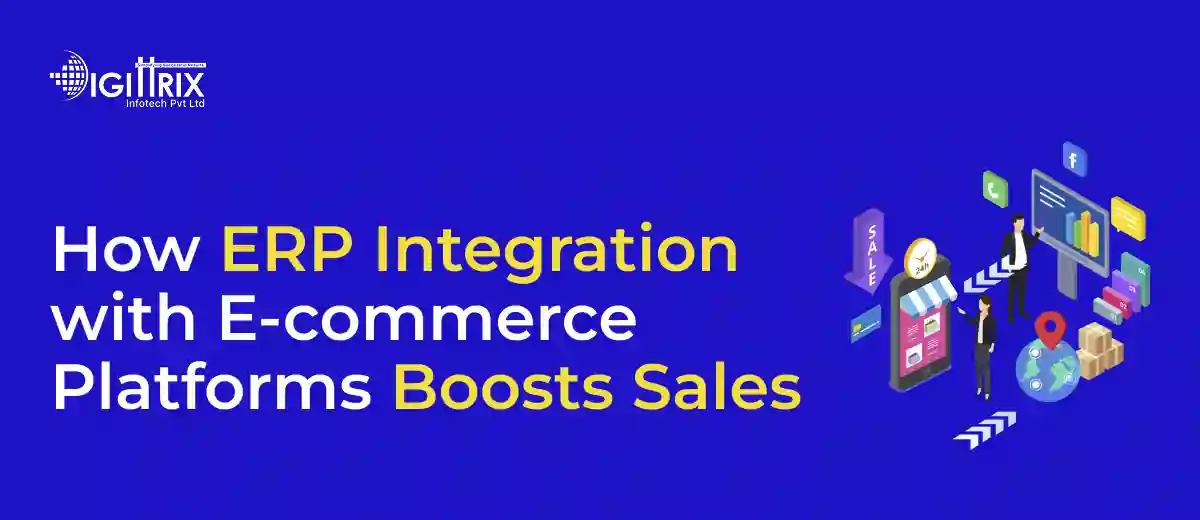ERP integration with e-commerce enhances order accuracy, speeds up delivery, reduces stock errors, and increases repeat customer purchases, leading to steady sales growth.
Highlights
With Over 14 years of Experience in the IT Field, Helping Companies Optimise there Products for more Conversions

Today, online shopping is a key way people purchase goods. When a business sells online, it uses tools to manage orders, stock, customers, and products. One of these tools is ERP (Enterprise Resource Planning). Another is an online shopping platform. If these two operate separately, managing everything can become slow and confusing. But when linked, they work much more effectively together.
Integrating an e-commerce app development platform with your business software system speeds up order processing. This benefits your customers and can boost sales. With the right setup, even small businesses can sell more with less effort.
Curious about modern business transformation? Explore how ERP integration is becoming the new standard for business success.
An ERP system is software that helps businesses monitor inventory, sales, orders, accounting, and customer details. Each business has unique needs. That’s where a customised ERP system comes in, giving a business the ability to manage things in its own way.
When your ERP system connects to your online store, that's called integration. This means your online sales and business software work together as a single system. As a result, when someone buys something online, your system is aware of it instantly.
A business might collaborate with a company that offers Custom ERP Software Development to efficiently develop and integrate both systems. This approach helps avoid errors and saves time.
When a customer visits an online store, they expect accurate stock levels and pricing. If the product appears available but is already sold out, customers might cancel orders or seek refunds. Integrating ERP with e-commerce ensures that stock levels are updated immediately after each sale. Pricing changes made in the ERP system, such as discounts, specials, or tiered pricing, are reflected instantly in the online store. This leads to fewer cancelled orders, fewer disappointed customers, and increased trust, ultimately resulting in more completed sales.
Manual work to export orders from the storefront and import them into the ERP can cause delays. Integrated systems send order information directly into the ERP, so invoices can be generated immediately and warehouse staff can start picking and packing straight away. Quicker fulfilment results in happier customers, positive reviews, and repeat purchases. This faster cycle, supported by the ERP system, can help increase total sales volume.
With ERP integration, a business can view inventory across multiple channels—warehouses, retail outlets, and online stores—at a single central location. This makes it much easier to identify which items are nearly sold out, which need to be reordered, and which are sitting idle in stock. By managing product supply more effectively, fewer items run out or sit unused. This helps maintain sales without overselling or needing to refund orders. A custom ERP software development process can generate reports and alerts that quickly flag low-stock items or overstocked lines.
When customer service staff have access to both order history and stock status in a single interface (the ERP system), they can respond to buyer questions more quickly and accurately. A shopper asking where an order is or if a product is back in stock receives instant answers. That satisfaction encourages returns, referrals, and positive ratings. When people feel well served, they tend to return, which helps boost sales over time.
When all sales data from the e‑commerce side is integrated into the ERP, the business can generate reports showing which products sell best, which marketing campaign was successful, and which region makes the most purchases. Insights from this data assist in guiding future buying decisions, promotions, pricing strategies, and marketing budgets. Such planning helps ensure sales trends continue to grow rather than plateau. When the ERP developers add dashboards or data exports, decision makers receive clear results.
An e‑commerce store runs a holiday sale with discounted prices on thousands of products. Without integration, prices must be manually updated in the store and back-end systems, which is slow and error-prone. If prices are incorrect in the ERP, revenue reports and profit margins could be affected.
With a solid integrated system, the discount pricing set in the ERP updates automatically at the store. When items are sold, stock levels decrease in the ERP immediately. Orders are processed smoothly. The business can monitor orders, sales volumes, margins, and inventory in real time. This allows quick responses if stock runs low or demand spikes. As a result, the promotion sells more items, and fewer orders are cancelled or returned.
A retailer sells through its website, on marketplaces (like Amazon or Flipkart), and in physical stores. Without a unified ERP system, each channel’s inventory might be managed separately, which can lead to errors: one channel overselling while another has stock sitting idle.
When integrated, the ERP system shows total stock across all channels, and orders from those channels are managed within the same system. This prevents one channel from overselling stock reserved by another. It makes sure each channel runs reliably and cuts down on cancellations. Customers see correct stock levels. Sales across all channels increase, and fewer mistakes help lower overhead costs.
Here are the main areas where integration matters most:
Ensuring consistent product information across the store and the ERP system builds trust and prevents confusion.
Real‑time inventory syncing prevents overselling and stockouts immediately.
Automatic order routing into ERP accelerates fulfilment, cuts delays, and enables quicker shipping.
Once the ERP manages shipping, tracking numbers can be sent to the e‑commerce store and customer, improving transparency and reducing customer inquiries.
If a customer returns a product, the store updates the order status. The ERP system then receives that status and automatically restocks the item. Refunds are processed promptly. This helps maintain high customer satisfaction and keeps operational costs low.
Sales figures are kept in the ERP system. Reports can highlight best‑selling products, areas of concern, or seasonal trends. Planning with accurate data helps increase profitability over time.
To see how sales improve, businesses can track:
After integration, many businesses report clear uplift: more orders, fewer mistakes, faster delivery, and better reviews. These outcomes make it easier to market the store and build long‑term customer loyalty.
A simple step‑by‑step process:
Identify which e‑commerce platform you use, what features you need, and how your ERP tracks products, stock, orders, customers, and payments.
Clarify how SKUs, price tiers, shipping codes, and tax rates should align between store and the ERP.
With ERP software development, the developer creates APIs or middleware that pass data between the store and the ERP.
Simulate orders, pricing changes, stock updates, and returns. Make sure each piece works and that there are no mismatches.
Move the integration into live mode. Monitor for any errors in the first days. Fix issues promptly.
Show your operations, customer service, and warehouse teams how to use the integrated system. Ensure they follow best practices.
Watch metrics like cancelled orders, delivery time, and stockouts. Adjust settings or improve the connector code where needed. Use ERP development services to maintain and upgrade the integration.
When handled well, this integration becomes a key business asset. Sales grow steadily, operations run smoother, and overhead costs fall.
Partnering with an experienced ERP Development Company can help you avoid these mistakes. A customised ERP system tailored for your business can include built-in testing, reliable connectors, and ongoing support.
Ready to take your online store to the next level? Explore the top seven reasons mobile apps are essential for e‑commerce success.
Connecting ERP with your E-commerce platform helps streamline order management, keeps product stock and prices accurate, reduces the risk of errors, and provides valuable data for business planning. This setup supports improved customer service and can boost sales. Working with an experienced ERP development company, building a strong connection between systems, and ensuring smooth operation are essential for steady business growth.
This pairing of ERP and e‑commerce systems offers precise control over products, orders, and customer experience. That reliability helps build trust, reduce friction, and encourage repeat purchases. Sales trends rise, errors decline, and teams can focus on serving customers rather than fixing mistakes.
Managing online orders, inventory, and customer data efficiently is essential for running a successful e-commerce business. A customised ERP system designed to suit your business needs can help connect your online store with internal operations and improve control across all areas.
At Digittrix, we create reliable ERP solutions for small and medium-sized businesses seeking better ways to manage products, pricing, orders, and customer records. With over 14 years of experience, our expert developers deliver practical solutions that address real business challenges.
If you're planning to connect your ERP with your e-commerce platform or want to build a system from scratch, our technical experts are ready to guide you through each step. We’ll help you understand the process and recommend the best options for your business.
To begin creating a system tailored to your goals, contact our team today. Call us at +91 8727000867 to discuss your needs. For more information, feel free to email us at digittrix@gmail.com.

Do you need help in ERP/CRM Development?




Join over 1500+ businesses we've already helped!
ERP integration links your ERP software with your online store, enabling real-time updates of inventory, orders, and customer data across both systems.
It enhances accuracy in pricing and stock levels, speeds up order processing, and improves customer service, leading to increased sales.
Custom ERP Software Development ensures the system matches your business needs, offering better control over products, pricing, and operations.
Yes, integrating ERP with your e-commerce platform minimises manual data entry, which decreases the risk of mistakes in orders, stock, and pricing.
Businesses aiming to grow online sales, improve efficiency, and manage customer data more effectively should partner with an experienced ERP development company.

©2025Digittrix Infotech Private Limited , All rights reserved.